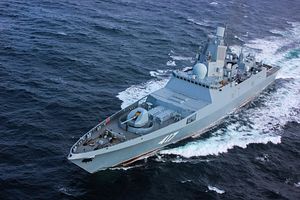The Severnaya Verf shipyard in St. Petersburg, part of the United Shipbuilding Corporation (USC), will lay down an additional series of Admiral Gorshkov-class Project 22350 guided missile frigates for service in the Russian Navy, the Deputy Defense Minister, Alexei Krivoruchko, announced on March 12.
“I want to assure you, the staff, that the book of orders formed and signed with enterprises of the United Shipbuilding Corporation, in particular, with the Severnaya Shipyard, will enable it to utilize its capacities at least in the next ten years,” Krivoruchko was quoted as saying on March 12 during a ship launch ceremony at Severnaya. “In the near future, we also expect and will lay the keels of additional frigates.”
Krivoruchko neither elaborated on the number of news ships to be built, nor reveal their planned delivery schedule. The deputy defense minister did specify that the new surface combatants will be Project 22350 guided missile frigates.
A total of six Project 22350 frigates have now entered service or are in various stages of construction. The Navy commissioned the long-delayed first-of-class Admiral Gorshkov in July 2018. The Admiral Kasatonov was laid down in 2009, christened in December 2014, and has been undergoing state trials with the Navy for much of 2019 and 2020. It is also the first serial-produced surface combatant of the class.
Two more Project 22350 frigates, laid down in 2012 and 2013, are expected to be commissioned this year. Two additional Project 22350 warships were laid down at the Severnaya Verf shipyard in April 2019. The 5,400-ton (full) Project 22350 class were designed to be the mainstay of the Russian Navy’s surface fleet. As I noted elsewhere:
Armed with stand-off anti-ship and land-attack cruise missiles, the frigates are multipurpose platforms designed for anti-air, anti-surface, and anti-submarine warfare operations. The ships can alternatively carry the 3M-54 Kalibr, a stand-off supersonic anti-ship cruise missile, the P-800 Oniks over-the-horizon supersonic anti-ship missile, or the 3M22 Zircon anti-ship hypersonic cruise missile. The fifth and sixth ships of the class will reportedly carry 24 instead of the 16 anti-ship missiles carried on the preceding frigates.
As I explained in April:
The [Project 22350] is also armed with an RPK-9 anti-submarine rocket launcher, two 3M89 Palash close-in weapon systems, and an A-192 130-millimeter naval gun, in addition to the Polimut Redut air defense missile system, which may not be entirely functional. Additionally, it carries aKa-27PL helicopter for anti-submarine warfare missions. The frigate, powered by a combined diesel and gas turbine engine, can reach top speeds of up to 30 knots.
The first two Project 22350 frigates are equipped with Ukraine-made gas turbine engines, in addition to Russian 10D49 diesel engines, while the remaining four will be powered by Russian-made copies of the M90FR gas turbine engine, estimated to be ready for serial production by the end of this year. The next batch of Project 22350 surface combatants will also be fitted with this Russian-made variant of the M90FR.

































